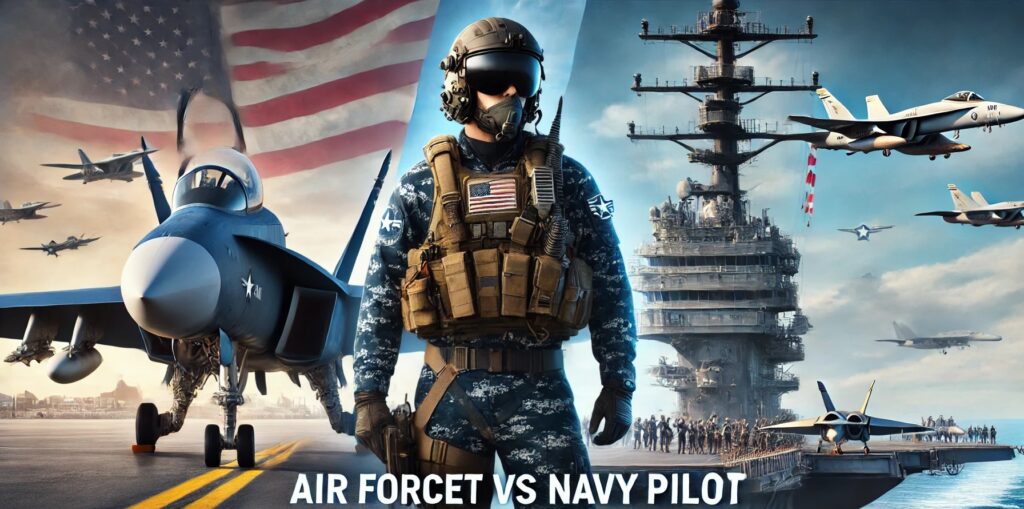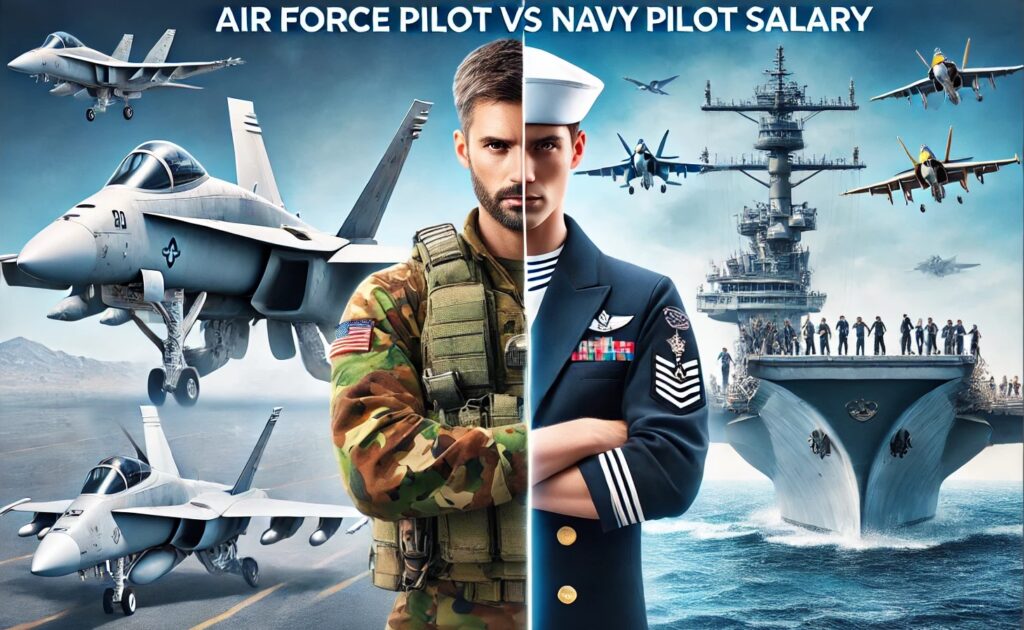When considering a career in military aviation, understanding the differences between being an Air Force pilot and a Navy pilot is essential. One of the most critical aspects to examine is salary. In this article, I will delve into the details of Air Force pilot vs Navy pilot salary, highlighting key factors that affect earnings, career progression, and overall benefits. Whether you’re an aspiring aviator or just curious, this comparison will provide valuable insights.
Basic Salary Structure “Air Force Pilot Vs Navy Pilot Salary”
Both Air Force and Navy pilots receive a basic salary determined by rank and years of service. However, the specifics can vary slightly between the two branches.
Air Force Pilot Salary
Air Force pilots, like all military personnel, are paid according to the Department of Defense pay scale. A new Air Force pilot, starting as a Second Lieutenant (O-1), earns a basic salary of around $3,637 per month, or approximately $43,644 annually. Moreover, As they advance in rank and gain experience, their salary increases. For instance, a Major (O-4) with ten years of service can earn about $8,000 per month, totaling roughly $96,000 per year.
Navy Pilot Salary
Navy pilots follow a similar pay scale to their Air Force counterparts. An Ensign (O-1) in the Navy starts with a basic salary of approximately $3,637 per month. As they rise through the ranks, their pay increases. A Lieutenant Commander (O-4) with ten years of service can expect to earn around $8,000 per month, equating to about $96,000 annually.
Additional Pay and Allowances
In both the Air Force and Navy, pilots receive various allowances and special pay that significantly boost their overall earnings.
Flight Pay
Both Air Force and Navy pilots are eligible for Aviation Career Incentive Pay (ACIP). This flight pay rewards pilots for their flying duties and can range from $150 to $1,000 per month, depending on years of aviation service.
Basic Allowance for Housing (BAH)
Pilots in both branches receive a Basic Allowance for Housing (BAH) to cover living expenses. The amount varies based on location, rank, and whether the pilot has dependents. For example, a pilot stationed in a high-cost area like San Diego can receive a BAH of around $3,000 per month.
Basic Allowance for Subsistence (BAS)
Both Air Force and Navy pilots receive a Basic Allowance for Subsistence (BAS) to cover food expenses. As of 2024, this allowance is approximately $280 per month.
Bonuses and Incentives
In addition to regular pay and allowances, pilots may receive various bonuses. Thus, The Air Force offers an Aviation Bonus (AvB) to experienced pilots who commit to additional service years. These bonuses can range from $15,000 to $35,000 annually. The Navy also offers similar bonuses under the Aviation Career Continuation Pay (ACCP) program, rewarding pilots for extending their service.
Career Progression and Earnings
The career trajectory for Air Force and Navy pilots involves progressing through the ranks, which directly impacts their salaries.
Air Force Pilot Career Path
Air Force pilots begin their careers as Second Lieutenants (O-1) and can advance to higher ranks such as Captain (O-3), Major (O-4), Lieutenant Colonel (O-5), and beyond. Each promotion brings a salary increase. For example, a Lieutenant Colonel (O-5) with 15 years of service earns approximately $10,000 per month, or $120,000 annually.
Navy Pilot Career Path
Navy pilots start as Ensigns (O-1) and can rise through the ranks to positions like Lieutenant (O-3), Lieutenant Commander (O-4), Commander (O-5), and higher. A Commander (O-5) with 15 years of service can earn around $10,000 per month. Like the Air Force, each promotion in the Navy results in a higher salary.
Deployment and Hazard Pay
Deployments and assignments in hazardous locations can further increase a pilot’s earnings.
Air Force Deployment Pay
Air Force pilots deployed to combat zones or hazardous duty areas receive additional pay. Imminent Danger Pay (IDP) adds $225 per month, while Hardship Duty Pay (HDP) can add up to $150 per month, depending on the location.
Navy Deployment Pay
Navy pilots also receive extra pay for deployments. Similar to the Air Force, Navy pilots can earn Imminent Danger Pay and Hardship Duty Pay, adding significant amounts to their monthly income during deployments.
Benefits Beyond Salary
Both Air Force and Navy pilots enjoy numerous benefits that enhance their overall compensation packages.
Health Care
Pilots in both branches receive comprehensive health care coverage for themselves and their families. This includes medical, dental, and vision care, significantly reducing out-of-pocket expenses.
Education Benefits
The military offers generous education benefits. Both Air Force and Navy pilots can take advantage of tuition assistance programs and the GI Bill, which covers college or vocational training costs during and after service.
Retirement Benefits
A significant benefit for both Air Force and Navy pilots is the retirement plan. After 20 years of service, pilots can retire with a pension that provides a significant portion of their final salary, ensuring financial security in retirement.
Travel Opportunities
Serving as a pilot in the Air Force or Navy offers unique travel opportunities. Pilots often travel worldwide, experiencing different cultures and locations, which is a significant perk of the job.
Work-Life Balance and Lifestyle
While the salaries and benefits are attractive, it’s essential to consider the lifestyle and work-life balance of Air Force and Navy pilots.
Air Force Pilot Lifestyle
Air Force pilots typically operate from well-established bases with extensive support facilities. This can lead to a more stable lifestyle, with predictable schedules and ample family time when not deployed. However, deployments can be lengthy and demanding.
Navy Pilot Lifestyle
Navy pilots, particularly those on aircraft carriers, experience a more dynamic lifestyle. Deployments on carriers can last several months, requiring adaptability to life at sea. The camaraderie and unique experiences aboard a carrier are significant, but the long separations from family can be challenging.
Training and Education Requirements
Becoming an Air Force or Navy pilot requires rigorous training and educational qualifications.
Air Force Pilot Training
Air Force pilots must have a bachelor’s degree, with preferred fields being engineering, physical sciences, or mathematics. They undergo Officer Training School (OTS) or attend the Air Force Academy, followed by flight training at specialized schools. The training includes Primary, Advanced, and Mission Qualification phases, ensuring pilots are well-prepared for their duties.
Navy Pilot Training
Navy pilots also need a bachelor’s degree, with similar preferred fields. They attend Officer Candidate School (OCS) or the Naval Academy, followed by Aviation Preflight Indoctrination (API). This is followed by Primary and Advanced Flight Training, where they specialize in their assigned aircraft. Navy training emphasizes adaptability, preparing pilots for operations on land and at sea.
Career Opportunities After Military Service
Both Air Force and Navy pilots have excellent career opportunities after their military service.
Civilian Aviation Careers
Many military pilots transition to civilian aviation careers, where their skills are highly valued. Airlines often prefer hiring former military pilots due to their extensive training and experience. This can lead to lucrative positions as commercial pilots, with starting salaries often exceeding $100,000 annually.
Government and Private Sector Jobs
Former military pilots are also sought after for government and private sector jobs. They may work as test pilots, aviation consultants, or in other roles that require advanced flying skills and experience.
Education and Training Roles
Retired Air Force and Navy pilots can pursue careers in education and training. They can work as flight instructors, teaching the next generation of pilots in military or civilian flight schools.
Job Satisfaction and Pride
Beyond the financial and practical benefits, the pride and satisfaction of serving as an Air Force or Navy pilot are significant.
Air Force Pilot Pride
Air Force pilots often take pride in their role as protectors of the nation. Flying advanced aircraft and participating in critical missions provides a sense of accomplishment and purpose.
Navy Pilot Pride
Navy pilots share similar feelings of pride, with the added dimension of operating in the unique environment of aircraft carriers. The camaraderie among naval aviators and the challenges of carrier operations contribute to a strong sense of identity and pride.
Air Force Pilot Salary Vs Navy Pilot “Final Thoughts”

Choosing between a career as an Air Force pilot or a Navy pilot depends on personal preferences, career goals, and lifestyle considerations. Both paths offer competitive salaries, excellent benefits, and the pride of serving as a military aviator. Understanding the differences in Air Force pilot vs Navy pilot salary, lifestyle, and career opportunities can help you make an informed decision.
For more information on military aviation careers and other aviation-related topics, visit Wings Over Cloud. Also, check out our latest product range. Explore our articles and resources to stay informed and inspired in your aviation journey!
Pilot Gun Secrets: Embark on Your Epic Airborne Journey Now!

